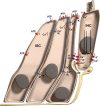Purinergic Modulation of Activity in the Developing Auditory Pathway
- PMID: 33040238
- PMCID: PMC7674525
- DOI: 10.1007/s12264-020-00586-4
Purinergic Modulation of Activity in the Developing Auditory Pathway
Abstract
Purinergic P2 receptors, activated by endogenous ATP, are prominently expressed on neuronal and non-neuronal cells during development of the auditory periphery and central auditory neurons. In the mature cochlea, extracellular ATP contributes to ion homeostasis, and has a protective function against noise exposure. Here, we focus on the modulation of activity by extracellular ATP during early postnatal development of the lower auditory pathway. In mammals, spontaneous patterned activity is conveyed along afferent auditory pathways before the onset of acoustically evoked signal processing. During this critical developmental period, inner hair cells fire bursts of action potentials that are believed to provide a developmental code for synaptic maturation and refinement of auditory circuits, thereby establishing a precise tonotopic organization. Endogenous ATP-release triggers such patterned activity by raising the extracellular K+ concentration and contributes to firing by increasing the excitability of auditory nerve fibers, spiral ganglion neurons, and specific neuron types within the auditory brainstem, through the activation of diverse P2 receptors. We review recent studies that provide new models on the contribution of purinergic signaling to early development of the afferent auditory pathway. Further, we discuss potential future directions of purinergic research in the auditory system.
Keywords: Auditory brainstem; Auditory system; Cochlea; Development; Purinergic signaling; Spiral ganglion.
Figures



References
-
- Burnstock G. Purinergic nerves. Pharmacol Rev. 1972;24:509–581. - PubMed
-
- Burnstock G. Introduction to purinergic signalling in the brain. Adv Exp Med Biol. 2020;1202:1–12. - PubMed
-
- Abbracchio MP, Burnstock G, Verkhratsky A, Zimmermann H. Purinergic signalling in the nervous system: an overview. Trends in Neurosciences. 2009;32:19–29. - PubMed
Publication types
MeSH terms
Substances
LinkOut - more resources
Full Text Sources

